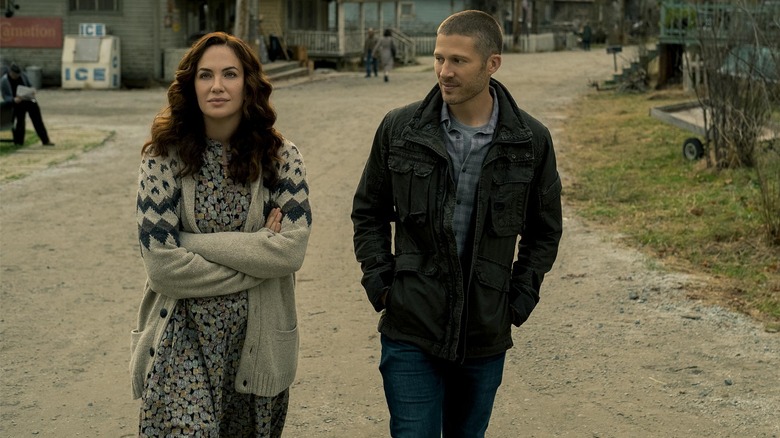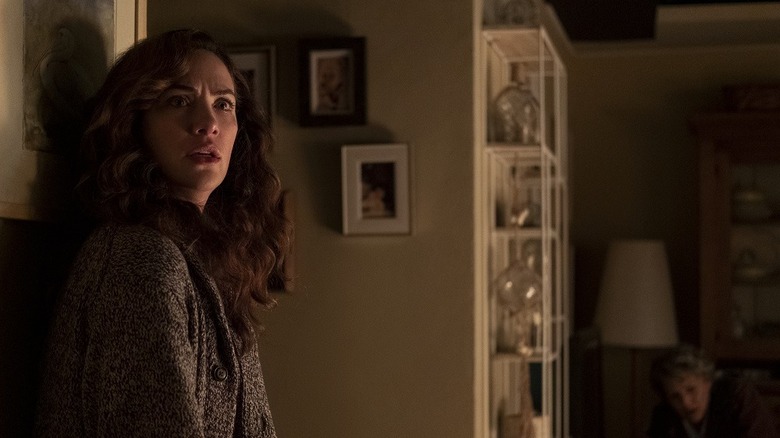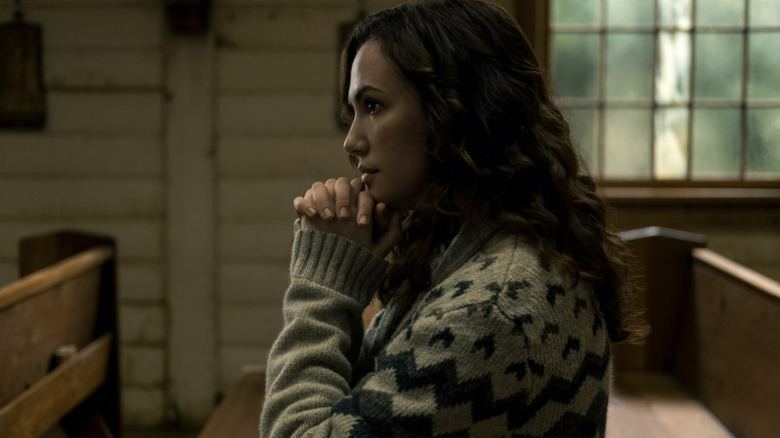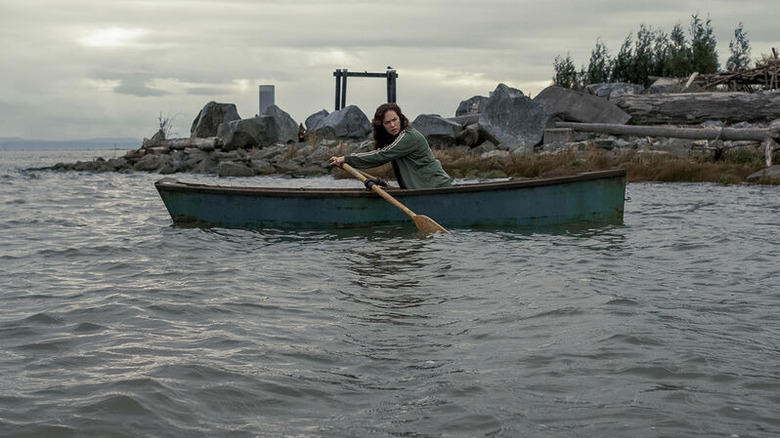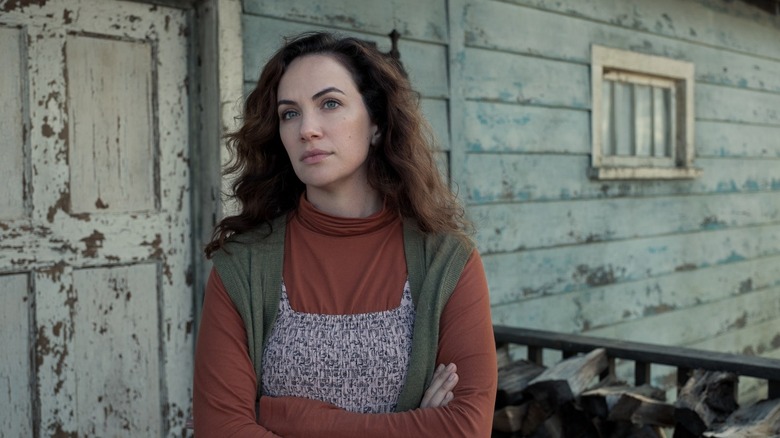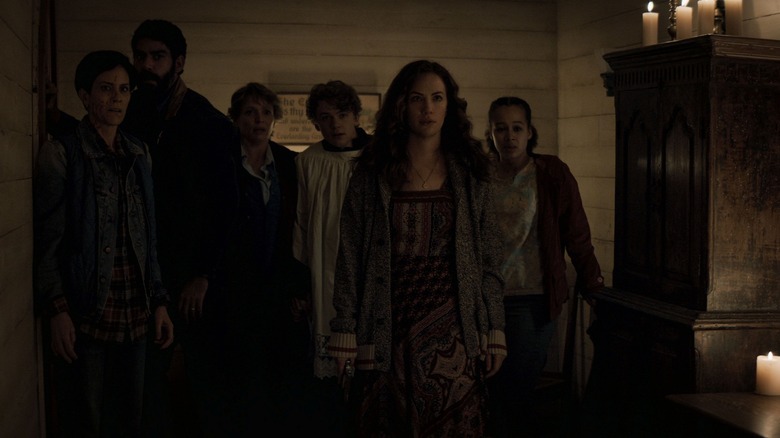Midnight Mass Star Kate Siegel On Performing That Monologue And Embracing Obsession [Interview]
Erin's faith in "Midnight Mass" is complicated yet pure. She's someone seeking community and peace, but at the same time, that respectful desire was born out of hardship and tragedy. She escaped her home and her mother, who called her a "godless heathen," only to return and continue to struggle with the past. She's one of the many rich characters in "Midnight Mass," which is another Mike Flanagan project that delivers equally compelling drama and horror.
For actor Kate Siegel, who also starred in "The Haunting of Hill House" and "Hush," Erin is a refreshing depiction of a churchgoer.
"What I liked about that is that it reminded me of many things that we discover in our adulthood about ourselves," she told us. "Like you may have told yourself your whole life, 'You know, I'm never really going to be a tea drinker. Tea is just kind of boring.' And then one day you find yourself having a cup of tea every morning, and it becomes something that you love because you chose it as an adult. You didn't choose it as a child who maybe was reflecting your parents' wishes or peer pressure from your friends, or anything like that. Erin's faith was a personal choice born out of life experience."
Recently, Siegel told us about her approach to playing Erin, her monologues, and how camera lenses influence her acting choices.
"We're going to get through this together."
On day one, you shot the rowboat scene, right?
Day one was the rowboat scene. Everything in the boat.
Was that a nice challenge to start with?
Early on, when they're making the schedule, there's always some back and forth dinner conversation between me and Mike about what's up first. Like, "Where are you starting?" Because with a show like this, when you have the whole cast who are going to be in, for reasons not only because of Covid, but scheduling reasons, everybody's there for the run of the show, he could start basically anywhere. If he wanted to start in the rectory, he could have started in the rectory.
Mike asked me, "How would you feel about starting with the rowboat on day one?" I laughed so hard. I was like, "You're so funny. Nobody would do that to someone. Oh, God. Okay." Mike hadn't worked with Zach [Gilford] yet, but Zach has been working for most of his adult life, he is an extreme professional, he's extremely talented, and Mike was like, "I trust you, Kate, to go with the road bumps of the first day of a Covid set, and if things go wrong, you probably won't walk out, and if you don't walk out, Zach will probably stay too."
I remember at one point, they put me and Zach in a tent and we weren't allowed to take off our masks, our goggles or our yellow ... I guess they looked like surgical gowns. I turned to our first AD and I was like, "I don't know how to do this. I don't know how to do my job if I can't see my scene partner's face." I was starting to freak out. Even in that moment, Zach was like, "It's okay. We're going to get through this." And that tone we set for each other, which was, "We're going to get through this together," permeated through that day and truly through the entire months of shooting.
You've said you two have different acting styles, but you came together so well. Does that happen often?
No, it does not always happen that way. I think it says a lot about Zach as a person, and I hope it says a lot about me as a person, that we weren't judgmental of each other. Because normally, when styles that are different meet, they can be a little bit like two cats meeting in a room, like, "Oh, you do backstory? You don't do backstory?" Or, "Oh no, you're method." But with both of us, we were easygoing with each other. And when it was his coverage, I worked in his way, and when it was my coverage, he would do the same for me. It was really cool.
Actors always say that is just one of their favorite qualities in a co-star. It's weird how many don't do that.
You would think that's like the basic level of human decency. It always surprises me when there are actors who are like, "Nah, it's 3:00 AM and I don't really feel like standing here for your monologue. I'm leaving." And it's like, "Oh, I didn't know that was an option. Okay." Although the last time someone did that to me, I had their stand-in come in, and the stand-in was a terrific actor. And so, I was grateful.
"We're both putting the pieces together, the viewer and Erin, as the monologue goes on."
Later on in the shoot, for the monologue day, were you able to see Zach's face more?
By that time, we had figured out sort of the way the protocols work, which is that actors are in something called "the red zone," which means everybody else has to be in top level of protection, which means they have to have eye covering, face shields, KN95 mask, and most of the time something covering them, like hair and makeup had to wear the surgical gowns. But by that point, Zach and I were allowed to be unmasked with each other, but nobody else could be near us. And so, we were very together in that time.
Also, on that day, there was a moment where we thought our DP, Michael Fimognari, wasn't going to be there, because he directed the "To All The Boys" movies and he had some extra days to do on that movie. And my heart broke because, if you've watched "Midnight Mass," it is so beautiful because of the love of Michael Fimognari. The way he finds light and the way that he lights scenes reflect the feeling of the scene.
I was so scared to go into that monologue day without Michael Fimognari, but because he's such a team player, things got moved around on both productions so that he could be there on that day. And there was such a sense of trust and faith in the room when we started monologue day. And then everybody, by the end of monologue day, was drained, just clawing their way out of set to get home and just sleep for a year.
How many takes did you typically do for the monologues?
So there were three monologues. For the "clipping the wings," the dove monologue, we did five takes; for "what happens when we die from the point of view of my daughter?" we did three takes; for the final "what happens when we die?" I believe it took seven takes, but we used take three.
What was it about take three that Mike knew it was right?
We felt it. I had some idea of wanting to try something else on take four, and then Mike saw that and wanted to try something else on take five. And then this'll happen sometimes on a set, where you'll get an idea and you'll go chase it, but you already had the take. So you're like, "Okay. So we have this safe take that we know is good and great and delivers what we're hoping for. What if we try it with a little bit more emotion?" But it became very clear that the monologue needed a little bit less gas on it.
"Everybody gets their time."
How did you find the pace and rhythm for those monologues?
That, I would say, is like 99% of my job, right? Hamish is a genius at this, about taking pacing and then pulling back, and then delivering and pulling back, and leading the viewer along and then holding them still and then jumping out at them. He's a genius.
I think I am pretty good at it, but most of the work that I do is trying to make it feel like I'm thinking of it in the moment, because with something as difficult as the "I am that I am" monologue, where you are truly talking about the essence of human existence and the return to the cosmos, it's a very high-concept idea, and the only way to perform that is to be experiencing it exactly in the moment or else people are going to feel like they're being lectured at in a philosophical way. And so, what I hope to have achieved is that I took the audience sort of in my arms and we all made these discoveries together. We're both putting the pieces together, the viewer and Erin, as the monologue goes on.
Was the table read good prep for those scenes?
It was the best. It really was. So much of the show in its final form was there on that day. You know, you got to see Sam Sloyan put on the Bev for the first time. And knowing Sam, she's very different than Bev, but meeting Bev for the first time, it's like, "Oh my God, she's the worst." And then Hamish is there, pounding on the table, yelling at Zach, and Zach's crying and I'm crying. And the kids are all there being kids and passing each other notes. There was an alchemy in the room, that there was something there.
It was only cut short by the fact that we all left basically the next day to go home and maybe never to get to do the show again. So for a long time, the table read was just this sad reminder of a show we weren't shooting.When the shooting began, I've heard this already, talking to a few people, they said it didn't feel like a typical TV show. There was time. It felt a little bit more like a movie. You'd do more takes.
How was the pacing for you?
I have a different point of view maybe than Zach or Hamish, because that's always my experience on an intrepid set, that they take the quality of their projects very seriously, and they give the actors the time. Everybody gets their time. Lighting gets their time, camera gets their time, the acting department gets its time. And of course, we're all on a tight schedule. Everyone wants to make the day. We're doing our best, but there's no department that's dismissed. There's not a reverence to acting that isn't given to props. We understand that props are important and they want to make sure their job is done.
"In the moment of acting when I want to be the most open, I lean into that light."
As you said before, you have a good relationship with cinematographer Mike [Fimognari]. What were some vital conversations you had with him on "Midnight Mass" that impacted your work?
Michael Fimognari is the unsung genius of this Flanagan/Fimognari partnership, because Michael Fimognari looks at the world like it's the matrix. He sees the ones and zeros of lighting. He sees light. When he looks at your face, he's not looking at your human face, he's looking at the light bouncing off your face and it tells a story to him. I've always found it very helpful to ask Michael about that story.
So at the beginning of a scene, I'll be like, "Hey, will you tell me where my hero light is?" Because he'll tell me, if I'm sitting here talking to you right now and the light was [higher up] here. First of all, he's mad because I haven't diffused the natural light, but the second thing he would say is, "Chin up and find that light. That's where the glow is." You can see it get warm on my face. And so I know that, in the moment of acting when I want to be the most open, I lean into that light. And so, he can help me tell my story through the visual medium.
And always knowing things, like actors knowing their lenses; knowing that the wider out your lens is, the more compressed your edges will get, or an anamorphic lens that'll curve on the edges; knowing what your face will look like and what changes. Mike Flanagan, who has an encyclopedic knowledge of film lenses, and Michael Fimognari, they'll talk to you all day about why they're putting this on a 45. They'll talk to you about why they're going to use the split diopter on this shot. It makes my job easier, because if I know that I'm a soft-focused background element, I know how to perform, but if it's a split diopter, it means both of us are in focus, so I need to make sure I'm doing my job back here.
Say for the rowboat scene, then, what lens was used? How'd it influence you?
So for example, the rowboat scene, there's a couple of moments where it is supposed to be Erin's angelic face. Now that's on a movie star lens, that's a 50 millimeter. And that means it's the perfect portrait lens. It's the one that is meant to show a face the way a face looks in real life. When I know it's that kind of 50 millimeter movie star closeup, you know that you don't have to do a lot with your face.
Once we got to more of the emotional screaming, they were using a lens that had a little bit more scope because they knew they were going to see the smoke and the sunrise. They were also doing me the favor of having more room to do my emotion. Because if you are really close to me, like if it's a super close up on a 75 or something, maybe even like a 45, whatever, if you're on a very close lens, I'm not going to do things that are very big because they're going to look weird, but if you're pulled back more, I have a little bit more room to do acting.
It's all purely from talking just the science of lenses with the director and the DP. It just helps with a little bit more of the blue collar aspect of it, like making sure that you're in your light, you know where your lens is and you know how to use it.
"It's attention-to-detail certainly, but it's like a ferocity."
Do you also ever ask Mike, say for monologues or scenes in that vein, "How do you plan on cutting this together?"
Well, generally, with those monologues, Mike Flanagan loves to do the slow push. One take. And so, that's beautiful because you get to watch the actor think, you get to watch them put the thoughts together in a monologue. But it's a lot more pressure, because if there are cuts in it, I can do the top half of the monologue great and then in take two, maybe the back half is great, and then take seven, and the middle's really good. Maybe that one line in take six is great. So, you have a lot more freedom to play around.
But when you know, on the day, it's going to have to be one take, you really have to get your focus in. Mike will let you know ahead of time. He'll let you know, "I'm going to have cuts in this. So let's try a bunch of different stuff and I'll pull the best stuff," or, "Nope, this is your oner." So generally, he says, "Don't f**k it up, Kate."
[Laughs] When is his attention-to-detail most apparent on a set?
All of it. He's like a Howard Hughes-level OCD creator. I think three days before it premiered on Netflix, he was on the phone with special effects, fixing the fire. He will pull it up for me on Netflix, because we have these little preview copies, and he'll say, "See? See here where it comes off the railing?" And I'll be like, "I absolutely do not see that at all." He's like, "It's an embarrassment," and he'll get back on the phone.
It's attention-to-detail certainly, but it's like a ferocity. It's a protected spirit of his vision. He is very, very dedicated to that level of top to bottom, like wardrobe, acting, writing, editing, sound. Hates to do ADR, won't do ADR. Will throw his fists up and curse at planes because he will wait out a plane. He's not going to let us do ADR on a scene.
Did you not do much ADR for this then?
What did I do for ADR? There are, I think, three lines of ADR in all of "Midnight Mass."
That explains why these projects turn out so well, though, that ... I don't know if obsessiveness would be the right word.
Obsessiveness is good, but it has a quality that isn't there because there's also a generosity. Obsessiveness implies a holding on, but what it is, is a generosity. I think most of the people who get hired on a Flanagan project love their jobs. The sound people, like the Newton Brothers, love doing music, and Michael Fimognari loves light, and Trevor Macy loves producing, and Troy Wagner loves pulling focus, loves the camera. What Mike gives everybody is permission to be as obsessed with what you love as you are.
As the actors, that's why they say we get so much time, he's like, "Yes. Your job is important. Obsess the way you want to obsess." And we never have to pretend that we're cool or it's just laidback and we're doing whatever. He's like, "No, we're here because we're fanatic about this."
What did you obsess over in "Midnight Mass" then?
I was obsessed with Catholicism. I was raised Jewish. Bat Mitzvah'd and all of that. I never was a part of the Christian culture. And my husband, Mike's an atheist. His parents are Catholic. And so, I spent a lot of time talking to my mother-in-law about faith and religion and what that meant to her, which is, what kind of faith is never represented? What is the religious person you've never seen on TV? She talked a lot about that, about how faith is a personal choice and it's personal to her and intimate. And she would never, ever force somebody to feel the way she felt about God.
And then, I got really obsessed with the Mary medallion that Erin wears. I shopped for that for months. I wanted to find the very perfect thing, and I ended up finding it. I think it was on Etsy and I had to order three of them. I think that was the only three this woman had. Just little things like that, so that when I got lost in the tidal wave that is a Flanagan production, because that obsessive generosity can wash through you, I could hold onto that necklace and remember who I was. Zach made fun of me for having backstory for all my clothes. That's true. I could look at my boots and remember where I got them, and it grounded me in the moment so I could get back into my kind of tiny, little hidey hole.
"Midnight Mass" is available on Netflix.
